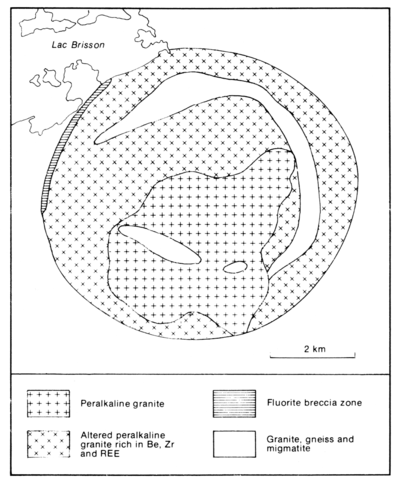stripes
Strange Lake is a circular, peralkaline granite pluton 7 km in diameter, emplaced in Proterozoic rapakivi granites and a diverse suite of gneisses and migmatites, which also form an arcuate screen within the pluton. The intrusion, the contacts of which are not exposed, consists of crudely layered porphyritic arfvedsonite-aegirine granite, with or without astrophyllite and aenigmatite, and containing numerous, variably metasomatized inclusions. Amphibole tends to be poikilitic, often includes aenigmatite, and may be rimmed by aegirine. Astrophyllite forms swarms of tiny needles, and pyrochlore and fluorite are common accessories. An upper layer, or possibly late saucer-shaped phase, contains high concentrations of Zr, Nb, Be and REE minerals including narsarsukite, elpidite, gittinsite and a gagarinite-like mineral. Along the northwest margin of the intrusion is a concentric zone of fluorite-rich breccia comprising rounded fragments of country rocks in a fluorite matrix; this is probably the youngest phase of the pluton. A range of chemical analyses is given by Currie (1985, Table 9.1).
CURRIE, K.L. 1985. An unusual peralkaline granite near Lac Brisson, Quebec-Labrador. Paper, Geological Survey of Canada, 85-1A: 73-80.

